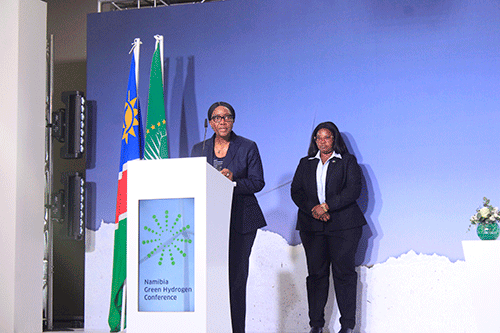Prime Minister Saara Kuugongelwa-Amadhila yesterday said Namibia is in the process of developing its national green hydrogen strategy.
The strategy will ensure overall direction and cohesion between new policies needed for the industry as well as existing legislative frameworks.
The PM made these remarks at the just-ended two-day Namibia National Green Hydrogen Conference 2022.
The conference brought together stakeholders from the public and private sectors to share experiences and learn best practices on green hydrogen under the theme: ‘Namibia: Towards a Green Hydrogen Hub in Africa’.
According to Kuugongelwa-Amadhila, Namibia is considering developing a full-scale green hydrogen industry with upstream and downstream opportunities for Namibia’s private sector along the entire value chain.
Upstream opportunities exist in areas such as wind turbines and solar panels assembly, IT services, consulting and water provision, while downstream prospects range from the production of fertilisers, green ammonia, green zinc, aviation and diamonds as well as the construction of port and rail networks.
“Namibia seeks to realise the full potential of the sector and identify areas for local participation and value addition for the country to take full advantage of such opportunities, create jobs and improve the socioeconomic welfare of Namibia’s people,” said Kuugongelwa-Amadhila.
She stated government is committed to establishing a competitive and transparent process for the development of the green hydrogen project, which is designed to maximise national benefits and lay the foundation for long-term participation in a growing global green hydrogen and ammonia market.
Namibia took the first step to position itself at the forefront of worldwide aspirations for green hydrogen production in 2021 by setting in motion plans to develop the country’s first vertically integrated green hydrogen project in the Southern Corridor Development Initiative.
The aim is to develop a major integrated high-capacity hydrogen project, valued at US$9.4 billion.
Meanwhile, the PM noted the project is expected to eventually produce 300 000 tonnes of raw hydrogen annually for the domestic, regional and international markets.
“It is estimated that this landmark project will create 15 000 direct jobs in the four years of integrated construction and 3 000 direct jobs during the first two phases while contributing to other efforts to promote economic stability,” she said.
Also speaking at the just-ended conference, deputy mines and energy minister Kornelia Shilunga said Namibia’s potential for scaling up a green hydrogen industry is massive, adding the country has the right ingredients, with some 3 500 hours of sunshine annually.
“Government needs to set rules and create a conducive policy environment in which public and private sectors can be empowered to accelerate green hydrogen deployment. On the other hand, players in the industry, such as suppliers, utility companies and transport manufacturers, also need to play their part to continue developing and supplying the appropriate technologies,” explained Shilunga.
She added government continues to level the regulatory system in creating demand for investment and enhancing attraction as well as decreasing tariffs and costs associated with green hydrogen production and distribution.
Also weighing in, international economist Robin Sherbourne said the key is for government to ensure the investment environment is right.
Sherbourne remained optimistic that Namibia will progress with this new ambition, saying he is confident it will spill over into numerous sectors.
At the same event, German ambassador to Namibia Herbert Beck advised that green hydrogen is coupled with long-term profits and remained confident the new sector will help fight Namibia’s many socio-economic challenges.
On Tuesday, the country’s green hydrogen commissioner James Mnyupe announced four successful applicants for pilot projects, who will receive funding to build green hydrogen projects in Namibia.
The successful applicants in the Erongo Valley are the Dâures project (agriculture), Namport applications (logistics), Cleanergy project (refuelling) and TransNamib project (logistics).
– mndjavera@nepc.com.na


